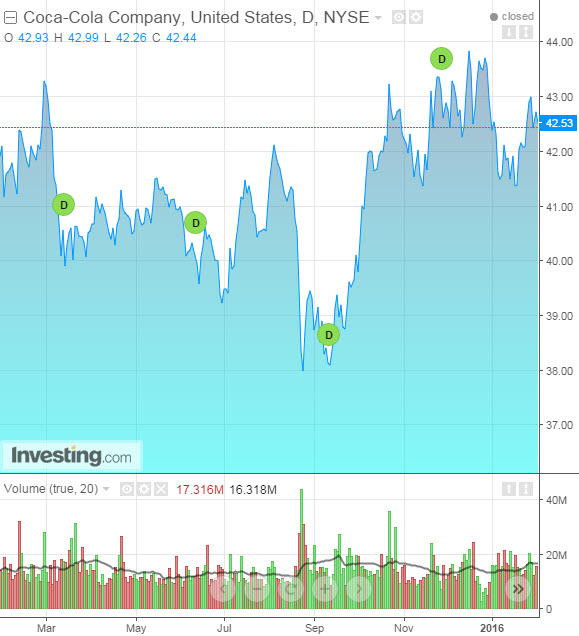by Clement Thibault
Among not so-savvy investors, as well as those seeking safe, relatively reliable bets, consumer staple stocks are extremely popular. These companies produce recession-proof household items such as personal care products or in the case of Coke and Pepsi, beverages and snacks. You can generally count on their dividends, and their share prices don't fluctuate too wildly over the short-term.
Products produced by these companies are usually purchased by most US households, and their stocks are often characterized by slow and steady growth—making them not too risky, but not too sexy either. The slow-and-steady growth results from the fact that demand for consumer staples is considered to have low elasticity, meaning their business cycle is relatively predictable and does not depend too heavily on the state of the overall economy.
PepsiCo (N:PEP) and Coca-Cola Company (N:KO))--which both report Q4 ’15 earnings this coming week—are mainstays of this sector. Both companies are among the world’s top food producers by market cap, with Anheuser-Busch Inbev (N:BUD) in first place ($189B market cap), followed by Coke at $184B, PepsiCo in third position at $141B, and Unilever NV (N:UN) ($123B) and McDonald`s (N:MCD) ($106B) rounding out the top 5.
So which stock is the better play going into Q4 earnings reports?
Both companies own multiple successful brands. In addition to its namesake Coca-Cola brand, KO owns Fanta, Sprite, Minute Maid and PowerAde, to name a few. Its counterpart PepsiCo owns such globally recognized beverage brands as Pepsi, Gatorade and Tropicana, but has also ventured into the snack aisle with its popular Frito-Lays and Quaker Oats brands among others.
In terms of revenue, both companies had a rough 2015. Their troubles were mainly caused by a strong dollar hurting overseas earnings. According to statistics portal Statista.com, in 2014 about 53% of KO’s earnings came from overseas, as opposed to 30% for PepsiCo. We’ve still to see what each company’s total foreign exchange losses were for the past year when their 2015 annual reports are published later in 2016.
In addition, instability in Venezuela forced PepsiCo to change their accounting methods there, erasing what the company had previously considered legitimate earnings and causing a massive $1.4 billion write down in Q3. PepsiCo has suffered from Quarter-over-Quarter declines in every report so far this year, as much as over 5% declines in revenue during both Q2 and Q3.
The EPS growth seen from PepsiCo in the first half of 2015 was only due to exceptionally effective cost cutting on the company's part. In Q1 2014, Cost of Goods (COGS) and Selling, General and Administrative Expenses (SG&A) totaled $10.8 billion for PepsiCo, while in Q1 2015 the same operations cost $10.4 billion, amazingly just enough to cover the $400 million drop in revenue during Q1 2015.
Coca-Cola suffered from the same drop in revenue, but its cost cutting methods weren’t nearly as effective as PepsiCo's. Its EPS dropped 25% in Q3, from $0.96 in 2014 to $0.72 in 2015.
Insofar as dividends, both companies are considered Dividend Royalty and have surprisingly similar characteristics. Coca-Cola and PepsiCo offer 3.07% and 2.84% dividend yields respectively, both higher than the average consumer staple stock, which yields approximately 2.56%. Both companies have a Payout Ratio of over 60%, and perhaps most important of all— both companies have been growing their dividend annually for decades: 43 years in the case of PepsiCo, 53 years for Coca-Cola.
PepsiCo's stock experienced several ups and downs in 2015. Its share price breached the $100 price point several times, but never managed to stay above it for an extended period.

Coca-Cola seemed to encounter a similar problem at around $44.

Overall in 2015, a down year for the S&P 500, Coca-Cola climbed 1.95% while PepsiCo rose a respectable 5.8%. Both companies are similarly valued in terms of P/E ratio, with Coca-Cola at 27.56 and PepsiCo at 29.41. However, PepsiCo enjoys a smaller price-to-dales ratio at 2.24, compared to Coca-Cola's 4.14. In addition, its price-to-free-cash-flow ratio is 37.84, well below the industry's average of 80.13 and less than a third of Coca Cola's 117.99. So, as far as valuations are concerned, one would find more value in PepsiCo than in Coca-Cola right now.
Looking ahead, both companies should continue to enjoy their high-profile status as household names and will no doubt remain at the top of consumers' favorites list. However, health concerns have become part of the current equation, as growing awareness of the potential health problems caused by sugar and fat looms larger in consumers' nutritional choices. Indeed, both companies are currently taking steps to reduce their products’ negative nutritional impact on consumers' diets.
In 2016, PepsiCo’s more diverse product roster will be its key differentiating metric. Indeed, its Frito-Lay division controls 36% of the growing US salty snacks market. This burgeoning market could make up for a decline in beverage consumption, something Coca-Cola cannot currently offset. As a result, the 2016 outlook for PepsiCo seems to be both safer and have better growth potential, two critical, and excellent, qualities.
This week's earnings reports will mark the end of 2015 for the two old rivals. Coca-Cola is set to report on Tuesday February 9th, with forecasts of $10 billion in revenue and $0.37 EPS. PepsiCo will follow shortly thereafter on Thursday February 11th, with its own forecasts of $18.7 billion in revenue and $1.06 EPS. Our assessment: Coke is good for now, but Pepsi is the future.
